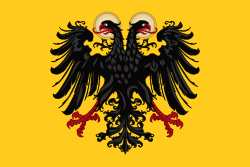
Back Придворен съвет Bulgarian Consell Àulic Catalan Říšská dvorní rada Czech Reichshofrat German Αυλικό Συμβούλιο Greek Consejo Áulico Spanish Conseil aulique French Konsili Aulicum ID Consiglio aulico Italian სამეფო კარის საბჭო Georgian
| Aulic Council | |
|---|---|
| Reichshofrat | |
 | |
 Banner of the Holy Roman Empire | |
| Established | 1498 (organization by Maximilian I) |
| Dissolved | 1806 (dissolution of the Holy Roman Empire) |
| Jurisdiction | One of the two supreme courts in the Holy Roman Empire, with concurrent jurisdiction with the Reichskammergericht on certain matters, and exclusive jurisdiction on others |
| Location | Prague, Wels, Frankfurt, and Vienna |
| Composition method | Councilors were appointed by the Holy Roman Emperor, with the exception of the Vice-Chancellor, which is appointed by the Elector of Mainz |
| Authorised by | Holy Roman Emperor |
| Number of positions | President, Vice-President, Councilor, Fiskal, and more |
| Language | Mainly German |
The Aulic Council (Latin: Consilium Aulicum; German: Reichshofrat; literally "Court Council of the Empire", sometimes abbreviated in academic writing as "RHR") was one of the two supreme courts of the Holy Roman Empire, the other being the Reichskammergericht (Imperial Chamber Court). Unlike the Reichskammergericht, which was tied to the Imperial estates, the Aulic Council was tied directly to the Emperor.
It had not only concurrent jurisdiction with the Reichskammergericht, but in many cases exclusive jurisdiction: the Aulic Council had exclusive jurisdiction in all "feudal" processes, and in criminal affairs, over the immediate subjects of the Emperor and in affairs which concerned the Empire, and more (see Responsibilities section below). It did not have a single set seat, rather, it was bound with the Emperor's residences. Prague, Wels, and Frankfurt, were all sites of the court,[1] but the most important seat of the Aulic Council was at the Hofburg residence of the Habsburg emperors in Vienna.[2]
Since 1960, the Aulic Council has been extensively researched in academia, with some of its former court files (of which there are more than 100,000 that still exist[1]) stored at the Austrian State Archives. It played a major role in the constitutional, legal, and political history of the Holy Roman Empire, and is considered one of the most prominent supreme courts in early modern Europe. In particular, the court helped stabilize the balance of power in the Empire and provided a forum for legal diplomacy, rather than violence. Historians often use the term "juridification" (Verrechtlichung) to describe this process of increased legal resolutions rather than violent resolutions in the Empire. As historian Eva Ortlieb puts it, "Like the Rota Romana and the Parlement de Paris, [the Aulic Council] ranks among the most significant supreme courts of Europe."[3]
- ^ a b Cite error: The named reference
:4was invoked but never defined (see the help page). - ^ Wilson, Peter H. (1999). The Holy Roman Empire, 1495 - 1806. Studies in European history (1. publ ed.). Basingstoke: Macmillan [u.a.] ISBN 978-0-312-22360-1.
- ^ Ortlieb, Eva, "Reichshofrat", Encyclopedia of Early Modern History Online, Brill, retrieved 2025-02-09
© MMXXIII Rich X Search. We shall prevail. All rights reserved. Rich X Search